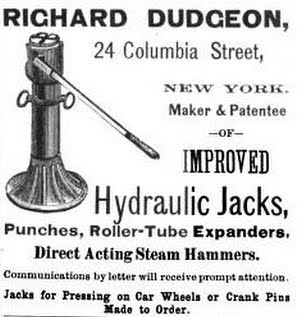 |
| From December 1880 Railway Purchasing Agent |
In 1848 or '49, Richard Dudgeon left his employ as scientist/engineer at Allaire Iron Works and opened a small machine shop. Shortly afterward local druggist Eliphalet Lyon funded Dudgeon's development of a portable hydraulic jack, an idea inspired by Dudgeon's observations of the activity at a nearby stone yard. In 1851 Dudgeon finished developing his first viable jack and obtained a patent. The jack was introduced to the market by E. Lyon (later E. Lyon & Co. and then the Watson-Stillman Co. As detailed in that entry for Watson-Stillman, a partnership, Dudgeon & Lyon, was briefly formed but it quickly ended in acrimony and a lawsuit. The partners split and each went into business for himself. Under his own name, Richard Dudgeon began making his patent hydraulic jack along with a series of improved and specialized versions.
In 1855 or '56 Dudgeon built a "steam carriage" whose engine had two cylinders, 3 by 16 inches, that made a speed of 10 miles per hour. It was destroyed in the New York Crystal Palace fire in 1858. The invention was ahead of its time and Dudgeon was unable to find a single customer even though it was a notably successful very early motor vehicle. In 1866 Dudgeon tried again, building a new and very similar version of his original vehicle, which was pitched as a trackless rail passenger car, or what we would now call a bus. Again it failed to attract any commercial interest. The vehicle languished in storage for years but is now in the collection of the American Museum of Natural History.
An ad in the 1867 New York State Business Directory shows that Dudgeon manufactured jacks, punches, locomotives, boilers, shearing and punching machinery and direct acting steam hammers. An ad in the 1867 San Francisco Directory features "R. Dudgeon's patent hydraulic lifting jacks & boiler punches, for sale by Eneas Dudgeon" in San Francisco.
Information Sources
- Advertising broadside dated 1853-01-01: Dudgeon's patent portable hydraulic press, or lifting jack: For raising heavy weights, stone, timber, boilers, locomotives, railway carriages. From Richard Dudgeon.
- New York State Business Directory, 1867, pg. 60
- Horseless Vehicles, Automobiles, Motor Cycles Operated by Steam by Gardner Dexter Hiscox, 1900 page 46
- 1907-01-07 The Iron Age article on the new Dudgeon hydraulic jack. Contains a historic overview of the evolution of the hydraulic jack, including cutaway views of the 1851, 1873, 1884, and 1906 Dudgeon jacks.1907-05-16 The Iron Age article on the Dudgeon hydraulic teting pump.1911 The Iron Age Directory lists "Richard Dudgeon, Broome & Columbia Sts., New York, as makers of hydraulic accumulators, hydraulic bending machines, hydraulic rail-bending machines, portable pipe bending machines, hydraulic machinery, hydraulic jacks, leather hydraulic packing, broaching presses, forcing presses, hand power presses, heavy hydraulic bending presses, hydraulic presses, hydraulic belting presses, hydraulic bending presses, hydraulic flanging presses, hydraulic forcing presses, hydraulic forging presses, hydraulic oil presses, portable hydraulic presses, hydraulic trimming presses, hydraulic wheel presses, power presses, tobacco presses, hydraulic pumps, electrically driven hydraulic pumps, power pumps, pressure pumps, and pressure floor pump.
- Museum of American History page on the 1866 Dudgeon steam wagon, and Wikipedia biography of Richard Dudgeon.
- Wikipedia page on Dudgeon's steam wagon.
- Grace's Guide page on Richard Dudgeon.
- 2010 Postscript had a Two-part article on Richard Dudgeon, including his role in moving Cleopatra's Needle, an enormous one-piece stone obelisk that was taken from Egypt and erected in Central Park.
- Article on Richard Dudgeon and his flying machine by Daniel E. Russell, city historian for Glen Cove, NY. In 1877 Dudgeon made one of the earliest serious attempts to design a flying machine, which was essentially a large kite powered by his patent steam engine.
- Catalogs with jacks by Richard Dudgeon on Archive.org.